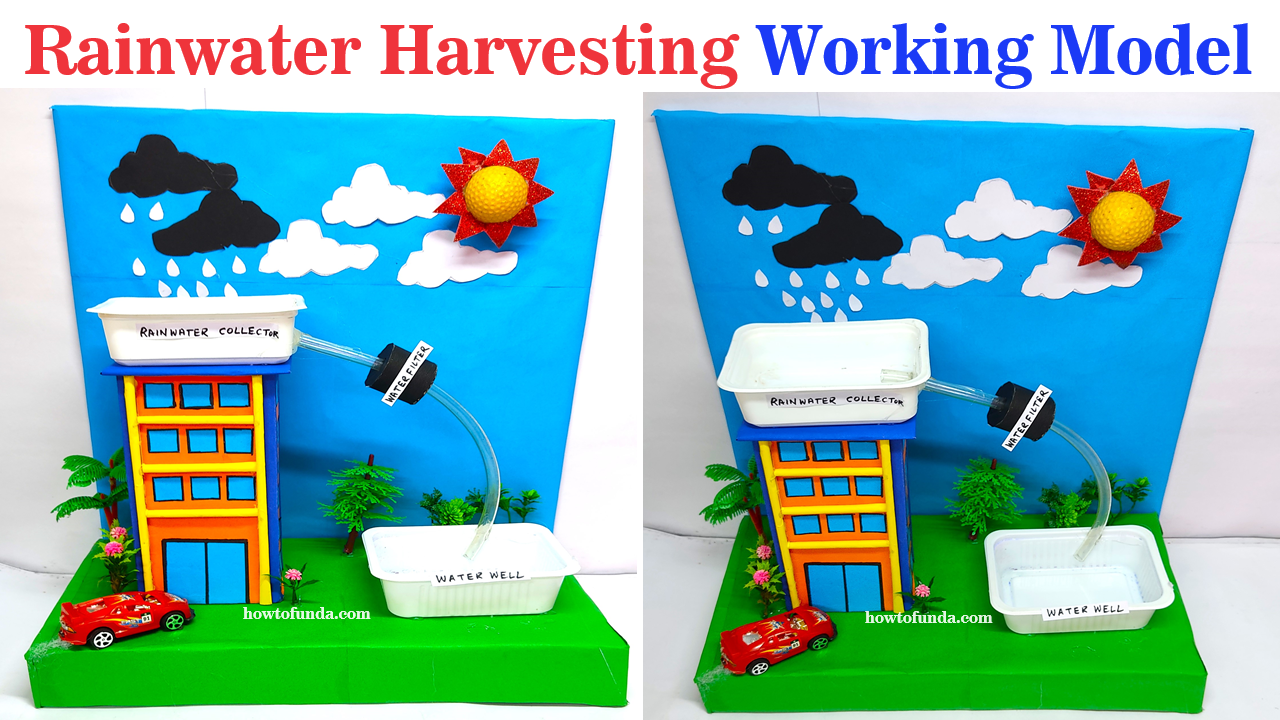A rainwater harvesting working model operates on the principle of collecting and storing rainwater for later use
Here’s an overview of how it works:
1. Collection of Rainwater:
- Rainwater is collected from rooftops, paved surfaces, or catchment areas using gutters, downspouts, or drains.
- The collected rainwater is directed towards a storage system, such as a tank or cistern, through pipes or channels.
2. Filtration and Pre-treatment:
- Before entering the storage system, rainwater may undergo filtration and pre-treatment to remove debris, leaves, and other contaminants.
- Mesh screens, filters, and sediment traps are commonly used to remove larger particles, while finer filtration systems may be employed to remove smaller contaminants.
3. Storage of Rainwater:
- Rainwater is stored in tanks, cisterns, or reservoirs for later use.
- Storage systems may be above ground, underground, or partially buried, depending on space availability and local regulations.
- Proper sealing and maintenance of storage systems are essential to prevent contamination and ensure water quality.
4. Distribution and Use:
- Stored rainwater can be distributed for various non-potable uses, such as irrigation, landscaping, toilet flushing, and outdoor cleaning.
- Depending on the application, rainwater may be gravity-fed or pumped from the storage system to the point of use.
- Water distribution systems may include pipes, hoses, drip irrigation systems, or sprinklers to deliver water where needed.
Creating a rainwater harvesting working model using cardboard, plastic trays, plastic pipes, and with representations of the sun and clouds is a great project for a science exhibition.

Here’s a step-by-step guide to making it:
Materials Needed:
- Cardboard
- Plastic trays or containers
- Plastic pipes (flexible or rigid)
- Small plastic bottle (optional, for water storage)
- Glue
- Scissors
- Blue color paper
- Yellow and white color paper (for sun and clouds)
- Marker
- Small pump (optional, for demonstration)
Step by Step Video Instructions:
- Prepare the Base:
- Use a large piece of sturdy cardboard as the base for your model.
- Cut the cardboard to the desired size and shape, making sure it’s large enough to hold the rainwater harvesting system.
- Create the Rainwater Collection Area:
- Use plastic trays or containers to represent the collection area for rainwater.
- Arrange these trays on one side of the cardboard base to collect rainwater.
- Glue the trays in place to prevent water leakage.
- Construct the Gutters and Pipes:
- Use plastic pipes or tubes to represent gutters and downpipes.
- Cut the pipes to the desired length and shape.
- Attach the pipes to the edge of the collection area (plastic trays) using glue, creating a pathway for water to flow.
- Add a Water Storage Tank (Optional):
- Cut a small plastic bottle in half horizontally to create a storage tank.
- Glue the bottle halves onto the cardboard base near the collection area.
- Connect the storage tank to the downpipe using plastic tubing.
- Create Sun and Clouds:
- Cut out a large circle from yellow color paper to represent the sun.
- Cut out several cloud shapes from white color paper.
- Glue the sun and clouds onto the cardboard base above the rainwater collection area.
- Add Details and Decoration:
- Use markers to add details to the rainwater collection system, such as arrows indicating the flow of water.
- Label different parts of the system, such as “Collection Area,” “Gutters,” “Downpipes,” and “Storage Tank.”
- Test Your Model:
- Pour water over the collection area to simulate rainfall.
- Observe how water flows through the gutters and downpipes into the storage tank or collection area.
- Optionally, use a small pump to demonstrate how collected rainwater can be pumped out for use.
- Display Your Model:
- Once your rainwater harvesting model is complete and tested, display it at the science exhibition.
- Consider adding informational posters or charts explaining the importance of rainwater harvesting and its benefits.
This working model effectively demonstrates the concept of rainwater harvesting and its potential for water conservation.

